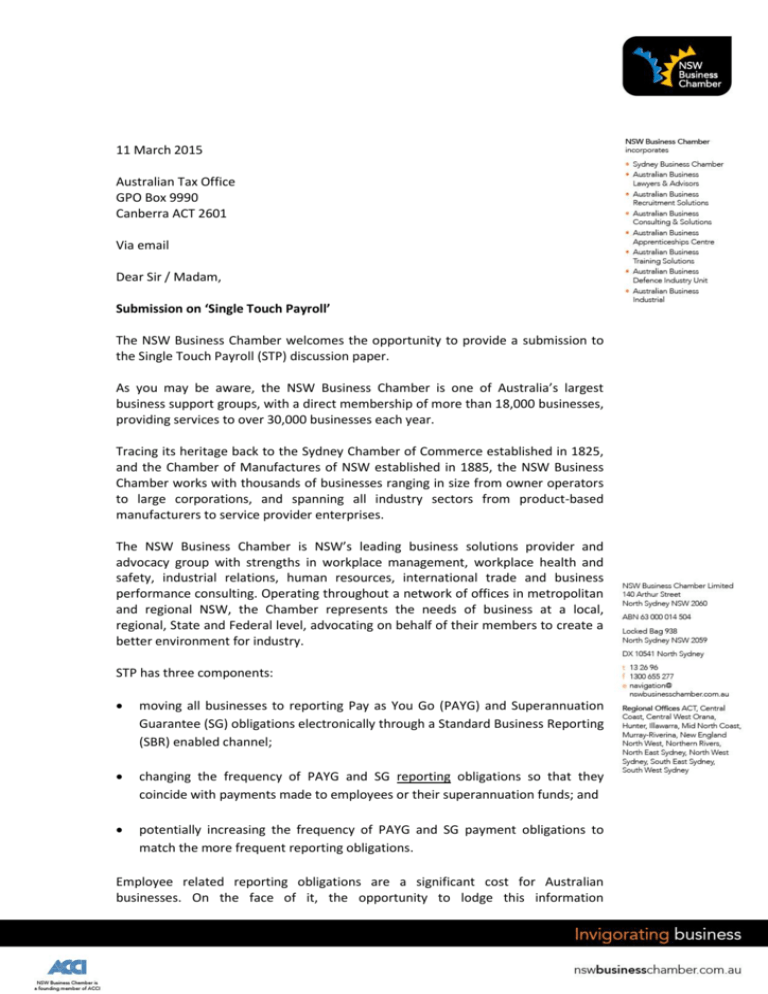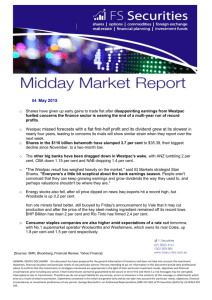11 March 2015 Australian Tax Office GPO Box 9990 Canberra ACT
advertisement

11 March 2015 Australian Tax Office GPO Box 9990 Canberra ACT 2601 Via email Dear Sir / Madam, Submission on ‘Single Touch Payroll’ The NSW Business Chamber welcomes the opportunity to provide a submission to the Single Touch Payroll (STP) discussion paper. As you may be aware, the NSW Business Chamber is one of Australia’s largest business support groups, with a direct membership of more than 18,000 businesses, providing services to over 30,000 businesses each year. Tracing its heritage back to the Sydney Chamber of Commerce established in 1825, and the Chamber of Manufactures of NSW established in 1885, the NSW Business Chamber works with thousands of businesses ranging in size from owner operators to large corporations, and spanning all industry sectors from product-based manufacturers to service provider enterprises. The NSW Business Chamber is NSW’s leading business solutions provider and advocacy group with strengths in workplace management, workplace health and safety, industrial relations, human resources, international trade and business performance consulting. Operating throughout a network of offices in metropolitan and regional NSW, the Chamber represents the needs of business at a local, regional, State and Federal level, advocating on behalf of their members to create a better environment for industry. STP has three components: moving all businesses to reporting Pay as You Go (PAYG) and Superannuation Guarantee (SG) obligations electronically through a Standard Business Reporting (SBR) enabled channel; changing the frequency of PAYG and SG reporting obligations so that they coincide with payments made to employees or their superannuation funds; and potentially increasing the frequency of PAYG and SG payment obligations to match the more frequent reporting obligations. Employee related reporting obligations are a significant cost for Australian businesses. On the face of it, the opportunity to lodge this information 1 automatically as part of normal business operations has the potential to deliver major administrative savings for many businesses. However, changing existing processes can involve significant costs, including purchasing or upgrading software and retraining employees. In some respects, larger businesses may be able to bear these costs more easily than small businesses, but they also face their own challenges because processes in larger organisations can be more difficult to change and because bespoke software solutions are more costly to upgrade. Clearly electronic reporting will result in significant administrative savings for the ATO, but the benefits of STP to businesses are unclear. The discussion paper is vague about the specific changes to lodgement obligations that would flow from the implementation of STP. The discussion paper is also silent on whether STP will also deal with other employee related obligations such as payroll tax, workers compensation and family payments. To the extent that there are administrative savings for business, it is not clear why these savings are more significant if information is reported in real-time. If no additional information is required beyond what would already be recorded in the ordinary course of business then the software can simply compute totals for the existing PAYG and SG payment schedule. If additional information is required, then reporting more frequently would actually be more burdensome. Disturbingly, the most obvious reason for requiring real time reporting of information is that it would mean that the software would be available to allow real time payment. Increasing the frequency of payment obligations would make enforcement easier and create significant cash flow benefits for government, but this would come at the expense of major reductions in cash flow for businesses. To assess the impact of STP on business operations, the Chamber conducted a survey with its membership between 23 and 28 February 2015 and 419 businesses responded. Timing did not permit survey testing nor extensive publicity of it, and the survey was only open for 8 days. The results indicate that most businesses oppose the introduction of STP, particularly any change to payment frequency. For the changes to reporting obligations, 65 per cent of businesses said that they would not change voluntarily and would require average compensation of around $10,000 equating to a total of $5 billion across all entities with PAYG withholding obligations.1 For the changes to payment frequency, 91 per cent of businesses said they would not change voluntarily and would require average compensation of around $11,000 1 Based on 65 per cent 823,655 entities with PAYG withholding obligations in 2012-13 2 equating to $8 billion across all entities with PAYG withholding obligations.2 Around 4 per cent of businesses reported that more frequent payment of PAYG and SG obligations would force them to shut down. Together these figures suggest a net negative for STP of $13 billion. This figure almost certainly significantly over estimates the costs of STP – in part because businesses have received very little information about what it involves. However, even at a 50 per cent discount this figure is still more than the entire red tape reduction commitment for the Government’s current term – this is a clear wake-up call. At minimum, the overwhelming opposition to STP from business is an indictment of the process so far. Each component of STP would significantly affect business operations, but the only opportunity for public comment has been a three week consultation period on implementation. The official announcement of the policy actually occurred between Christmas and New Year’s Eve.3 The process for the development of STP does not seem consistent with the Government’s own Guide to Regulation, which states among its 10 principles that: “every substantive regulatory policy change must be the subject of a Regulation Impact Statement” and “the information upon which policy makers base their decisions must be published at the earliest opportunity”.4 The Chamber has five recommendations for dealing with the concerns raised by business. 1. The Government should make a public commitment that it will not require an increase in the frequency of PAYG and SG payments 2. The costs and benefits of changes to PAYG and SG reporting obligations for business should be explored more closely and transparently through better consultation and communication with business and the accounting profession 3. Whether changes to PAYG and SG reporting obligations become mandatory should be based on the experiences of businesses during an initial voluntary period or pilot study 4. The benefits of STP to the government should be publicly disclosed. 5. If STP is made mandatory because of the benefits to government, businesses should be compensated appropriately. Additional results from the survey are provided in Attachment A. 2 Based on 91 per cent 823,655 entities with PAYG withholding obligations in 2012-13 See http://jaf.ministers.treasury.gov.au/media-release/001-2014/ See http://cuttingredtape.gov.au/handbook/ten-principles-australian-governmentpolicy-makers 3 4 3 The Chamber wishes to thank the ATO for the opportunity to provide a submission on this important matter. The Chamber’s policy contact for this matter is Tim Hicks (02 9458 7259 or tim.hicks@nswbc.com.au). Yours Sincerely Paul Orton Director, Policy & Advocacy NSW Business Chamber 4 Attachment A – Additional Results from NSW Business Chamber Single Touch Payroll Survey Changes to reporting Regarding the changes to reporting obligations, 69 per cent of businesses believed STP reporting changes would increase red tape and 35 per cent reported that the increase would be major. Only 12 per cent of businesses believed that STP reporting changes would reduce red tape and 19 per cent saw no difference. Around 35 per cent of businesses said that they would adopt STP reporting changes voluntarily. Based on open responses, the reason that a number of businesses would adopt STP reporting changes voluntarily despite seeing no administrative savings may be due to the belief that it will result in greater tax compliance from competitors, more certainty about the financial circumstances of debtors, and increased protection of superannuation entitlements for employees. The remaining 65 per cent estimated that on average they would need $10,000 compensation (based on 87 responses) suggesting a total net negative for these businesses of $5 billion.5 The typical compensation required drops to about $2,000 if the median is used rather than the average, but this still represents a total cost of $1 billion. We believe these figures probably overestimate the costs of change – partly due to limited information provided to businesses so far. The quantification question in the survey also failed to specify a specific time-period so weekly and quarterly amounts were converted into one off annual figures. All figure annual figures or figures without time periods were assumed to be one off. Regardless of these shortcomings, the results show that businesses currently believe that the cost of implementing STP would be equivalent to rolling back a significant proportion of the Government’s progress on red-tape reduction. Qualitative responses suggest that the perceived costs include software purchases and upgrades, training on new systems and software, time taken to understand the changes, and additional bookkeeping and accounting costs. Perceived benefits included better cash flow management, reduced paperwork and better transparency, but many businesses could not see any benefits and believed that the benefits would largely accrue to the government. Changes to payment frequency Regarding changes to payment obligations, 4 per cent of businesses reported that the cash flow implications of the proposed changes to PAYG payment frequency would be so extreme that they would be forced to close their business. A further 35 per cent of businesses reported a major cash flow impact, 42 per cent reported a minor impact and only 19 per cent of businesses reported no significant impact. Around 31 per cent of businesses said they would need to seek additional finance to meet more frequent payment obligations. 5 Based on 65 per cent 823,655 entities with PAYG withholding obligations in 2012-13 Many businesses already struggle with cash flow issues. Over 14 per cent of businesses surveyed reported that their cash flow was very constrained and they struggled to meet their obligations. A further 38 per cent reported they had limited cash reserves but were able to pay their obligations in the ordinary course of business. Relatedly, 15 per cent of businesses said that overdue invoices were a major problem and a further 47 per cent reported that they were a minor issue. Only 9 per cent of businesses were willing to adopt more frequent payments voluntarily. The average compensation required by the remaining 91 per cent was $11,000 (based on 70 responses) suggesting a net negative of more than $8 billion.6 The typical compensation required drops to about $2,600 if the median is used rather than the average, but this still represents a total cost of about $2 billion. The question requesting quantification of the compensation required for moving to more frequent payments suffers the same shortcomings as the question requesting quantification of the compensation required to adopt the reporting changes. Nevertheless, businesses are more likely to be able to accurately estimate the cash flow implications because they are less uncertain than the administrative changes. Demographic information Respondents were predominantly small businesses: 2 per cent were sole proprietors 21 per cent had 1 to 4 employees 43 per cent had 5 to 19 employees 17 per cent had 20 to 49 employees 17 per cent had 50 or more employees Respondents were evenly split between PAYG obligations above and below $100,000: 18 per cent had obligations less than $25,000 32 per cent had obligations from $25,001 to $100,00 16 per cent had obligations above $200,000 3 per cent were unsure Less than 2 per cent reported being bad with computers, though this likely reflects the online nature of the survey and around 84 per cent already use payroll software. A variety of approaches (sometimes more than one) were used by respondents to report PAYG and SG obligations: 28 per cent use paper forms 66 per cent lodged online 24 per cent lodge via their tax agent 2 per cent lodged in other ways 6 Based on 91 per cent 823,655 entities with PAYG withholding obligations in 2012-13 6




